Want to start your RV adventures? First, you’ll have to find the right motorhome to purchase or to rent. Don’t know where to start, or are you confused with the different types of RVs like the fifth wheel and the travel trailer? Worry not, as this comprehensive guide will teach you everything you need to know about how to choose an RV for your budget and needs.
This article will cover a complete RV comparison that highlights the benefits and features of the different types of RVs so you can have the easiest time making an informed decision, whether you’re a first-timer seeking to buy or rent a motorhome or an existing owner considering upgrading or downsizing your RV.
For those who are completely new to the world of off-road camping, you can skip to the second section of the article first to learn about the most important factors to consider when choosing the right types of RVs for you and your companion.
Contents
The Basic Types of RV #1: Motorized RVs
Motorized RVs means you will be driving inside the RV instead of towing the RV behind your pickup, which would fall into a different category called “towable RVs”. As the name suggests, these motorized RVs have engines and are constructed on a specially-designed motor vehicle chassis.
The advantage of motorized RVs is you won’t have to deal with the hassle of hitching and unhitching the vehicle at camp. Another plus is easier handling. Since the engine and living quarters are located under the same roof, first-time or less experienced drivers would have less trouble when turning and maneuvering compared to driving with another vehicle in tow.
This category includes Class A, Class B and Class C motorhomes, some of which will further include a few subcategories.
Class A
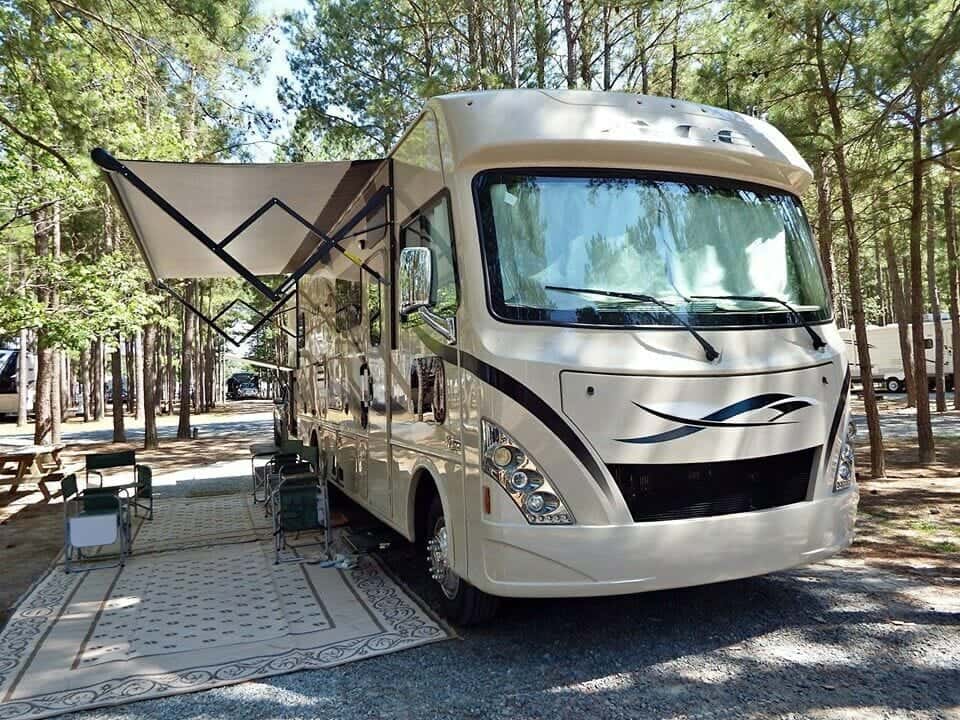
Pros:
- Large and luxurious living areas
- Full amenities for utmost comfort
- Ample storage
- Ideal for full-time, long-term camping
Cons:
- Expensive to buy, repair, insure and fuel
- Hard to maneuver due to size and blind spots
- May require towing a smaller vehicle for errands and excursions
- Some states may require a special license to drive the largest Class As
With a Class A motorhome, you will be driving inside the RV. This means if you would like to bring your car to go explore in a compact vehicle, you will be towing it behind the RV. Do note that only certain types of vehicles can be towed behind an RV.
Essentially, a Class A motorhome is an all-in-one RV, perfect for families and large groups who need a lot of room and privacy, plus a high level of comfortability and convenience. A Class A usually includes a lounge and dining area, a fully-equipped kitchen with sufficient counter space for cooking, a bathroom with shower, and one or two separate bedrooms.
Slide-out is a common feature you can find in many Class As, which serves to increase the interior space.
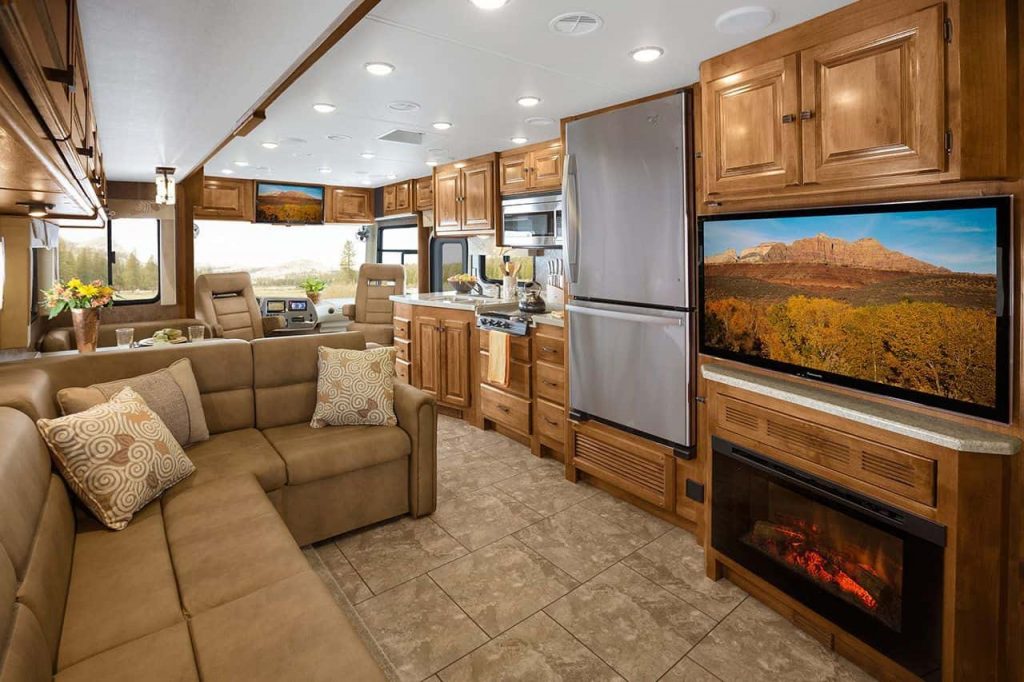
Class A motorhomes can be further divided into diesel and gas-powered. In comparison, the diesel engine, which is located in the rear of the coach, provides more torque compared to its gas-powered counterpart. Such a location of the diesel engine allows for a quiet and smooth ride.
In addition, another advantage is that the diesel engine usually lasts longer and is more durable than the gas engine on Class A motorhomes, however that makes them more expensive, too.
In short, if you are looking for a spacious and luxury RV, Class A diesel motorhomes are ideal choices as they are specially designed for long trips and can even handle cross-country adventures with ease. Many full-time RVers describe them as the perfect RV, or effectively, the perfect alternative home.
>> READ MORE: Top Rated Class A Diesel Motorhomes for the Money
Class B
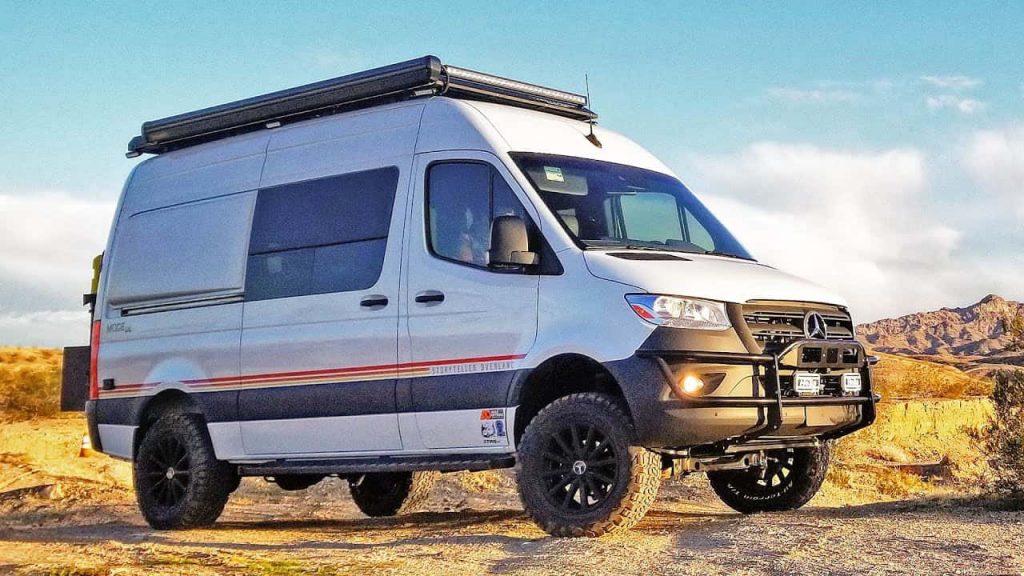
Pros:
- Cheaper to buy, fuel and repair
- Compact, thus very easy to drive, just like a van
- Classic and trendy look, especially vintage models – Instagram-worthy
- Ideal for single travelers and weekend getaways
- Convenient for day trips or errands
Cons:
- Fewer amenities than Class A motorhomes
- Very limited living space
- Often without bathrooms and space for laundry
- Limited storage
- Insurance for vintage models can be expensive
If you travel alone or with your spouse and do not need a whole lot of space, then a Class B might be a great option. They’re ideal for weekend getaways, single travelers and spontaneous travelers due to their compact size and drivability.
Class Bs are also called campervans or van campers or a van conversionIt is sometimes called, since they’re typically built on a standard (full size) or extended van with a raised roof for extra head room for walking upright.
Thanks to such small van chassis, these RVs are quite compact and drive much like a van, which is much easier to maneuver for less experienced drivers. In terms of drivability, Class Bs are among the easiest RVs to drive. And there’s no need to tow an extra vehicle behind for day trips and excursions, as these compact RVs are perfect for exploring around.
Another advantage of owning one of these Instagram-worthy little cuties is that Class Bs are also typically more affordable to maintain and fuel than their larger counterparts.
Vans come in different sizes and heights, thus if you want to, say, be able to stand up straight inside the Class B, there are many models with high roof for tall travelers, despite not being a pop-top.
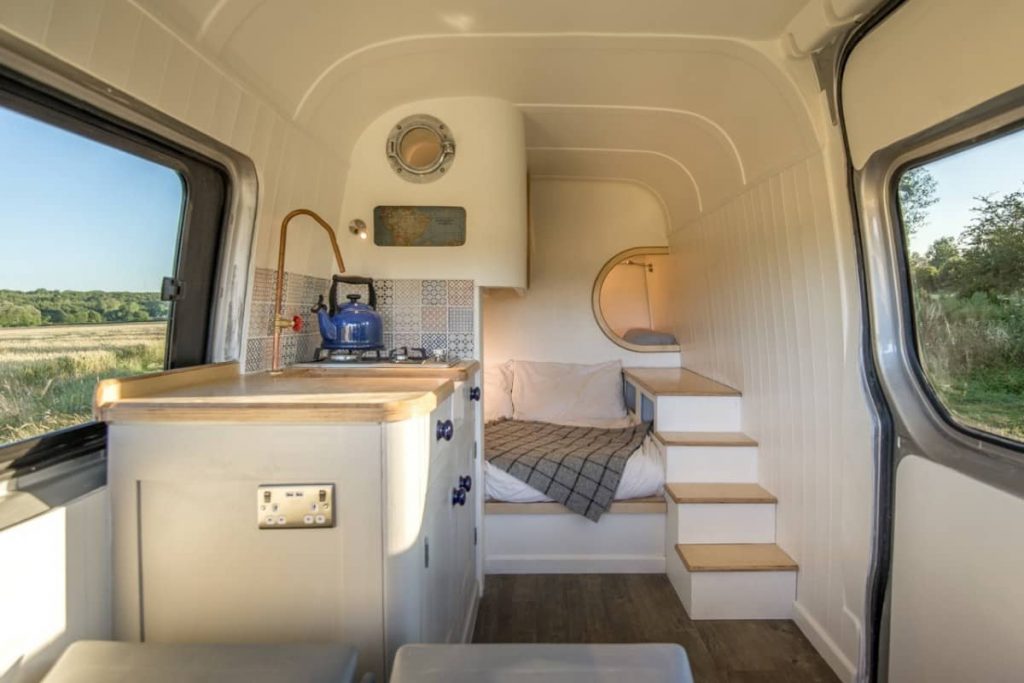
Often without a bathroom and space for washing and drying clothes, a Class B is suitable for shorter trips. A typical Class B is equipped with basic kitchen appliances, a bed/dinette combo and sometimes a toilet for the larger sized vans.
You can also find models with a number of handy solutions for the limited space, such as a kitchen and/or dining unit which can be extended or pulled out from the back door to offer outdoor dining. Other space-maximizing features include swivel toilets, folding sinks, convertible couch/bed combo and more to make the most of the limited space.
A typical campervan typically sleeps one or two people. Although many technically claim that they can sleep up to four, after two people a Class B will start to feel a bit too cozy for a comfortable night’s sleep.
Class C
Pros:
- Spacious living and sleeping areas
- Fully-equipped with all basic amenities
- Extra storage or sleeping area above driver’s cab
- More maneuverable than Class A
- More affordable than Class As and some vintage Class Bs
Cons:
- Driving can still be challenging for new RVers
- Cheaper to maintain, repair and fuel than Class A but is still costly compared to Class B
- For less experienced RVers, may require towing a smaller vehicle for easy moving around
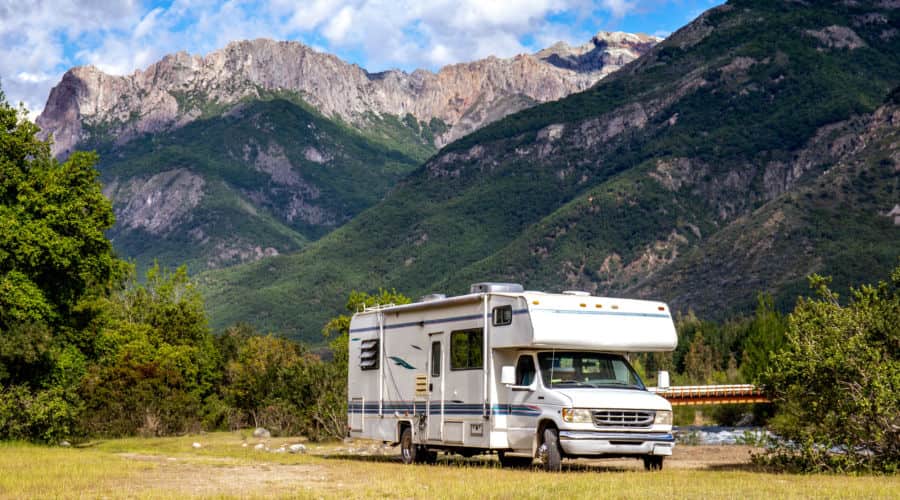
If you cannot decide between Class A’s space and comfort versus Class B’s drivability and versatility, and can afford a bit more than the average price for a Class B, here is the great news: Class C combines the best features of both Class A and B, making it a highly versatile, drivable and relatively affordable mid-size motorhome.
So in short, this type of RV is an excellent option for budget-minded full-time RVers since they offer a full range of amenities and decent space at a relatively affordable price.
A Class C RV is built on a truck chassis and typically range in size from 20 to 33 feet, with an extra cab over the driver’s compartment. This extra space usually houses the bed.
This truck chassis means that in terms of drivability, Class C is more agile than Class A and is the easiest to drive in after the van-like class B. With a class C, you are basically driving a pickup truck with something attached on top of it.
Confident drivers may eschew the option of towing the family car along for grocery shopping, other errands and excursions, although less experienced owners might need to tow an extra vehicle, as Class Cs are not quite as easy to drive as Class Bs.
Most Class Cs have a dining area which converts into a bed, a kitchen, and a bathroom, which means more comfort than a Class B. Motorhomes of this class are typically more spacious than a Class B and offer many of the same amenities as a Class A, including ample sleeping quarters and storage. As such, a Class C can house a family who would like something easier to drive than a Class A, or a couple who want more space and a built-in bathroom.
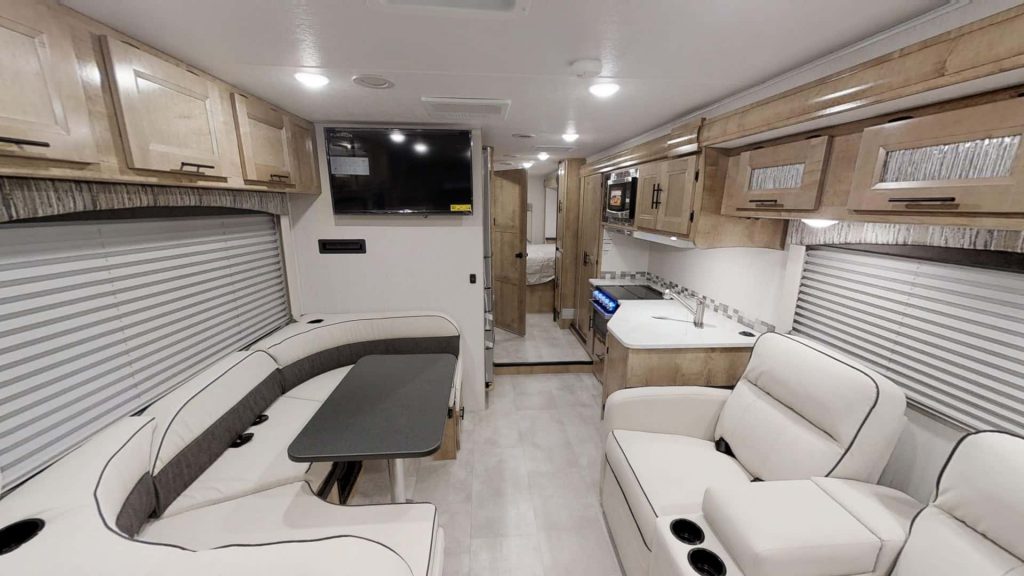
Regarding purchase price, a Class C motorhome is typically cheaper than a Class B, despite offering more amenities. However, do note that the fuel and maintenance costs tend to be higher, although not as high as a Class A. This is an important factor if you’re a full-time RVer and plan to hold on to your investment for at least ten years.
>> READ MORE: The 10 Best Class C Motorhomes Under 30 Feet
The Basic Types of RV #2: Towable RVs
Unlike the above motorhomes or motorized RVs, towable RVs are, well, towable with a towing vehicle being either a truck or an appropriately sized passenger car. Therefore, the RV can be unhitched, or disconnected from the towing vehicle, so you can use the more compact vehicle for grocery shopping, other errands or excursions.
Such a feature allows for a unique set of pros and cons compared to motorized RVs. Let’s find out about the different types of RVs below to see which class of towable RVs is right for you. And for more valuable reviews and comparison, head to our comprehensive RV guide articles.
Fifth Wheels
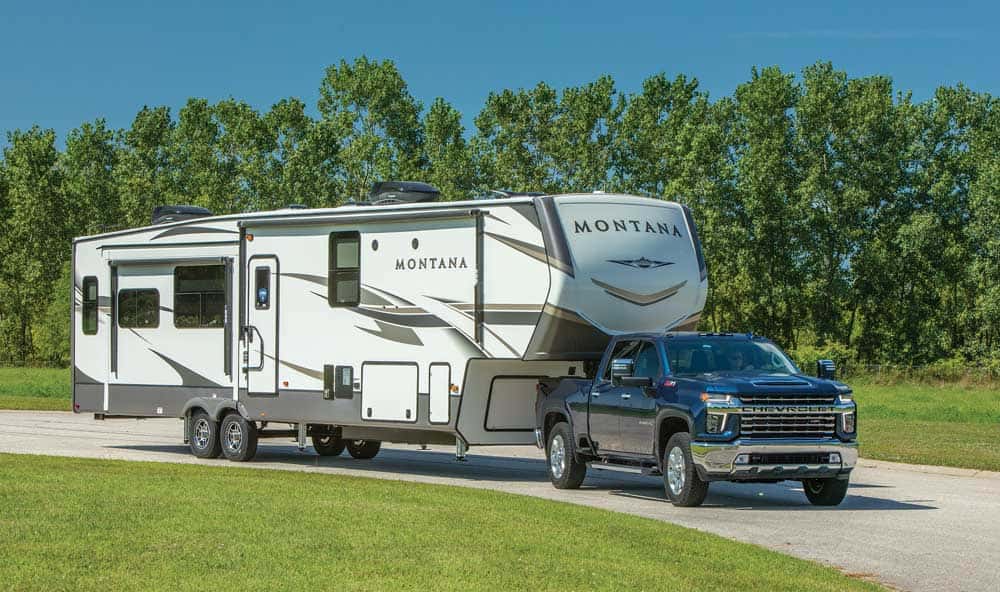
Pros:
- Spacious and luxury living space
- Ample storage
- Relatively affordable compared to similarly-sized Class As and Class Cs
- Fully equipped with amenities
- Can be unhitched to free up towing vehicle for easy moving around
Cons:
- Require large towing vehicle
- Due to size and towing, can be intimidating to drive, especially in reverse
- During travel, passengers must not ride in the fifth wheel, thus limited passenger space in towing vehicle
Fifth-wheel trailers are the largest and most luxurious of the towable RVs. Categorized as being on the fancy side, a 5th wheel offers the same level of comfort a Class A does. Accordingly, they’re also the most expensive in the towable RVs category.
Because of their large size, which can range from 20 to 40 feet in length, these fifth-wheel trailers require at least a large pickup truck or conversion vehicle to tow. Note that not every vehicle can tow a fifth wheel: you would need at least a pickup truck for the job. A fifth-wheel connects to the tow vehicle via either a fifth-wheel hitch or a gooseneck hitch, which provide a stronger and more maneuverable connection than other types of hitches.
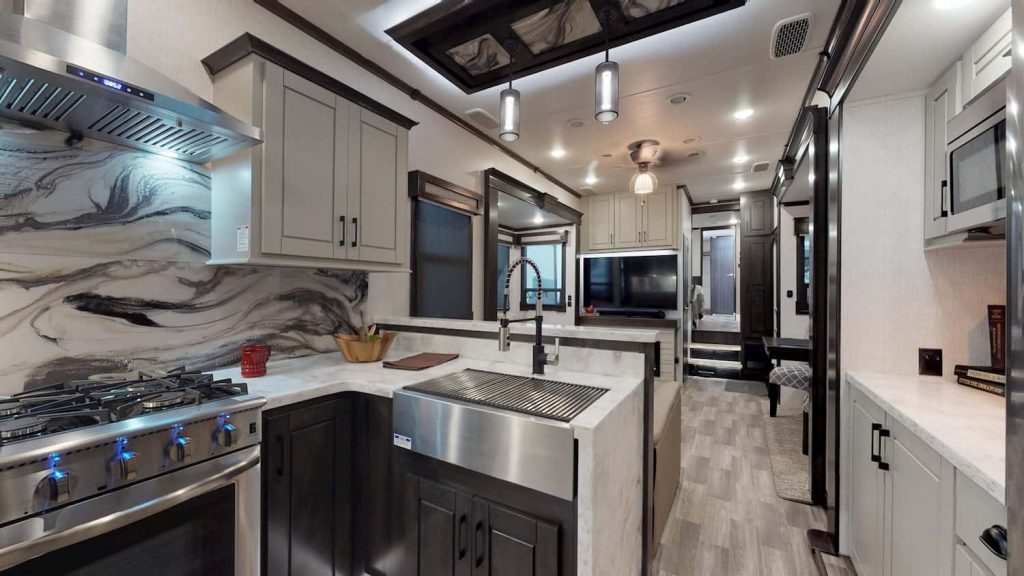
This RV class usually gives you the most living space. Fifth-wheels typically include full-size kitchens and baths, ample storage and sleeping accommodations for up to eight people. Slide-outs offer additional interior space, and the gooseneck hitch allows for a unique and convenient feature — multiple living levels — which is not available in other types of RVs.
On the flip side, such size also means having to drive a very large unit around. In addition, you’re not driving one whole unit, but two units attached by a hitch, which makes handling very different. Some driving and parking practice before the actual trip is recommended.
Compared to a Class A, a fifth wheel allows you to park your rig at the campground and drive around in your towing vehicle to explore, which might be more ideal.
>> READ MORE: The 10 Best Small 5th Wheel Trailers
“Toy Haulers” Fifth Wheels
Pros:
- Easily transport, load and unload cargo and gears
- Living area fully equipped with basic amenities
- Can be unhitched to free up towing vehicle for easy moving around
Cons:
- Less livable interior space compared to similarly sized RVs due to large garage/cargo area (but can be converted)
- Hard to drive, especially in reverse
- Tail swing can be an issue
- Like fifth wheels, limited passenger space during travel
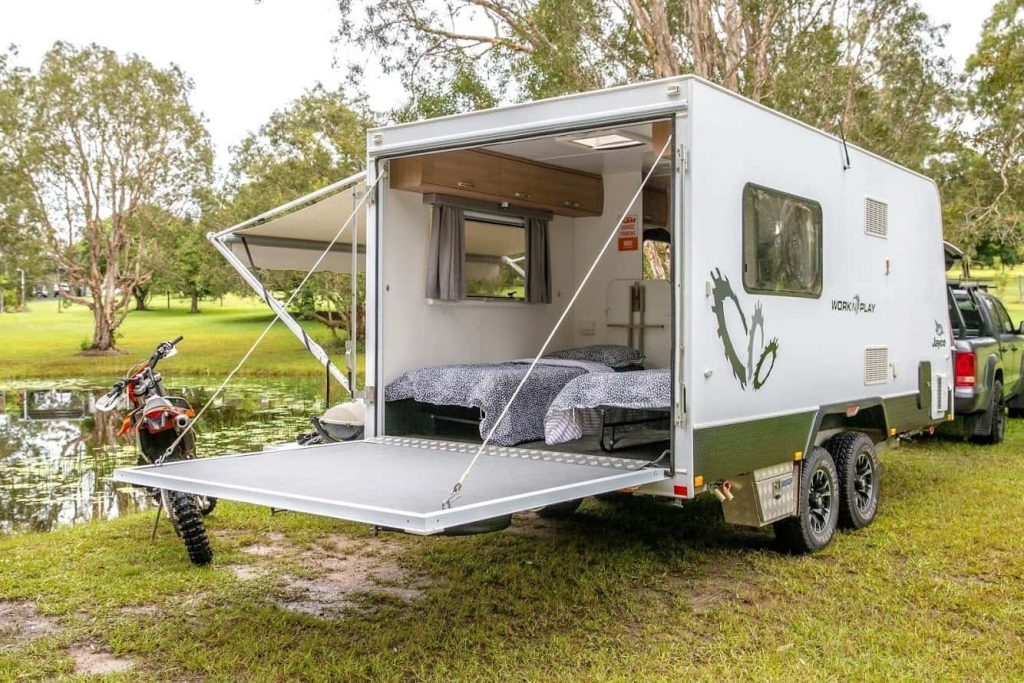
Most toy haulers, sometimes called sport utility RVs, fall into the fifth wheel class, although some are also available in motorized RV types. This version of the fifth wheels are specifically built to accommodate tons of gear and outdoor toys – including motorcycles, dirt bikes, golf carts, four wheelers, snowmobiles, kayaks, and more – hence the name.
To do this, this subclass offers a highlighted feature – a large cargo area/garage with special heavy-duty doors that double as ramps for loading gear. Thus, toy haulers are truly the perfect basecamp for the active, adventurous campers. A side note: the rear section with a pull-down ramp can easily convert this space into additional storage or even a home office.
On the downside, these RVs come with a few challenges: poor maneuverability, tail swing and limited living space, unless the garage is converted.
>> READ MORE: The 10 Best Fifth Wheel Toy Haulers For Full-Timing
Travel trailers
Pros:
- A wide range of sizes and floor plans available
- Depending on the size, can be towed with trucks or passenger cars
- Affordable compared to similarly sized Class As, Class Bs and Class Cs
- Can be unhitched to free up towing vehicle for easy moving around
Cons:
- Hard to drive, especially in reverse
- Tail swing can be an issue, especially with larger models
- Limited living space and amenities with smaller models
With this type, you have a wide range to choose from. Travel trailers come in all shapes and sizes, from the tiniest 4-foot teardrops (which will be discussed right after) all the way up to 40-feet long models with room for up to eight people, with varying interior features.
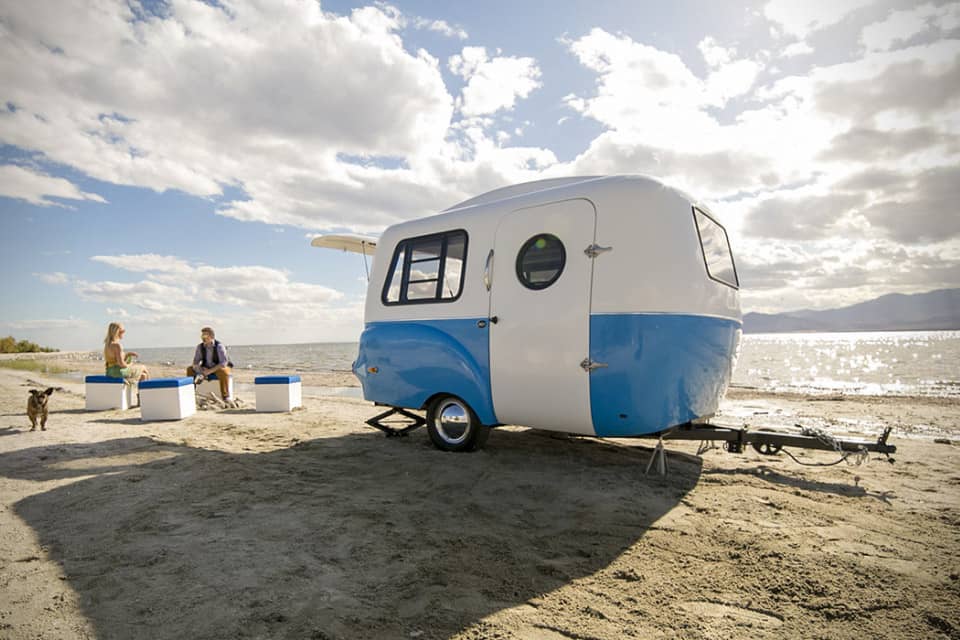
A travel trailer is more compact compared to a fifth wheel or a Class A, and thus doesn’t offer the same luxurious amenities. While it is the safest bet if you already own a pickup truck to tow, travel trailers can be towed by any vehicle rated to handle their weight capacity. This means that in many cases, there’s a likely chance that you can find an appropriately sized travel trailer for your family car, so you won’t need to upgrade your existing vehicle for towing.
Having that said, note that as mentioned above with fifth-wheels, it is generally illegal to ride in a travel trailer while in motion, so you’ll need a large enough towing vehicle for the drive, especially long rides.
>> READ MORE: Top 10 Ultra-Lightweight Travel Trailers Under 2,000 Lbs
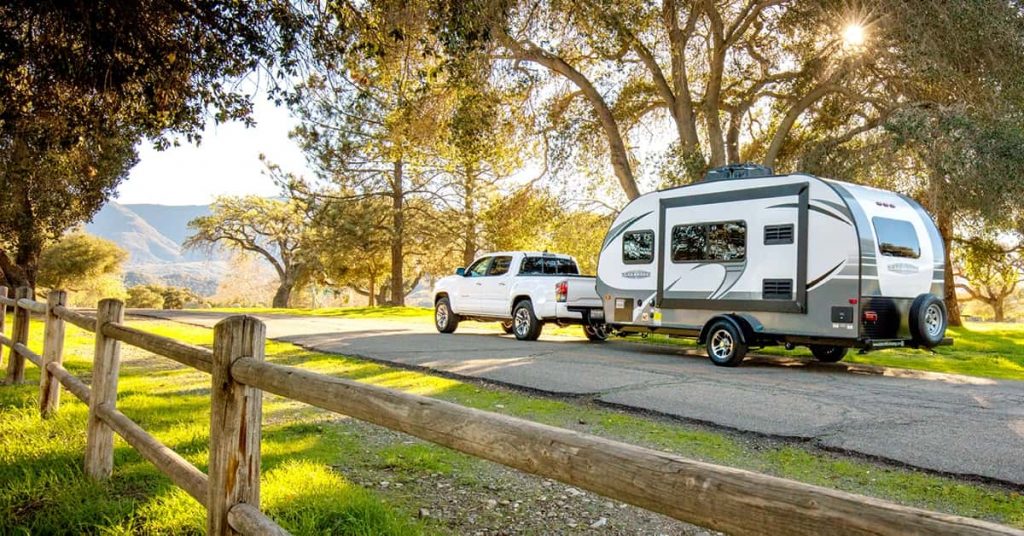
In terms of varying floor plans and amenities, larger models can be fully equipped with multiple bedrooms, spacious kitchens and full baths. For a mid-size trailer of 25 to 35 feet in length, you can enjoy a lounge, a dinette/bed combo, a kitchen, a bathroom and a private bedroom. The smallest travel trailers may simply offer sleeping space for one or two people plus some modest cooking facilities.
Teardrop travel trailers
Pros:
- Affordable
- Smaller models can be easily towed with passenger cars
- Can be unhitched to free up towing vehicle
Cons:
- Limited living space and amenities
- Little to no storage space
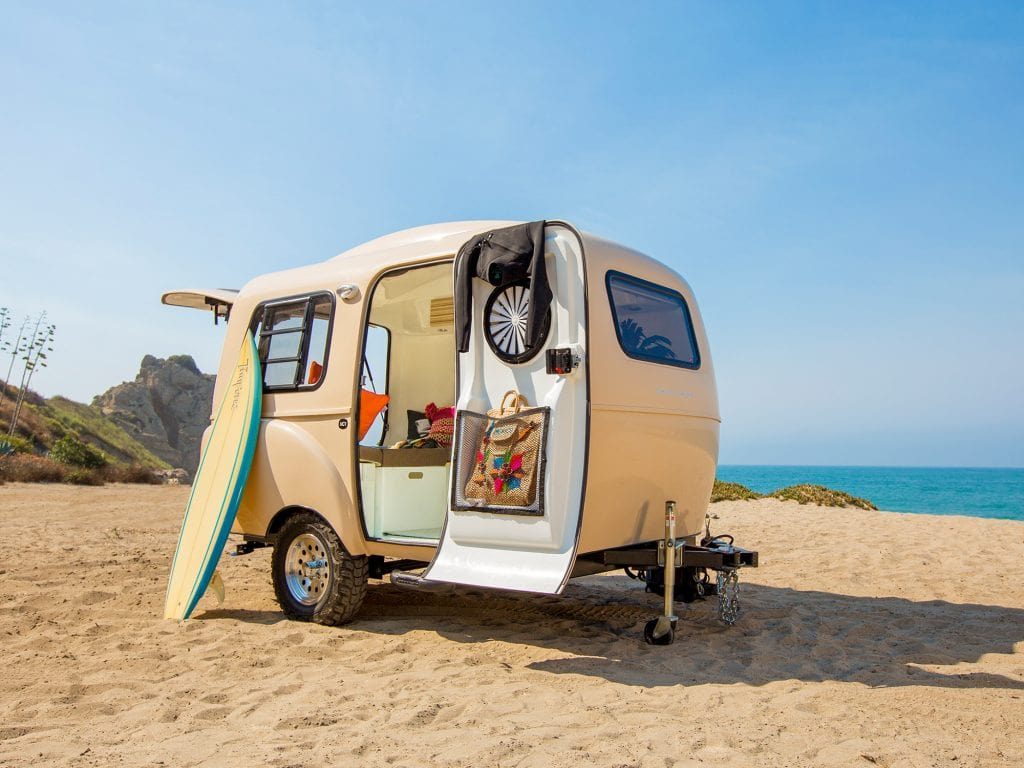
Among the many types of RV, teardrop trailers, a subclass of the above travel trailers, are the most easily recognizable thanks to its distinct teardrop shape. Thanks to their small size and being lightweight, teardrop trailers are ideal for weekend travelers who prioritize compactness, drivability and affordability and are willing to forgo some comfort.
These RVs typically weigh less than 4,000 lbs, thus is ideal if you are not willing to upgrade your existing passenger car to a pickup to be able to tow an RV behind. Among the different types of RVs, teardrop trailers might be the most suitable for budget, first-time travelers who often go on short weekend trips.
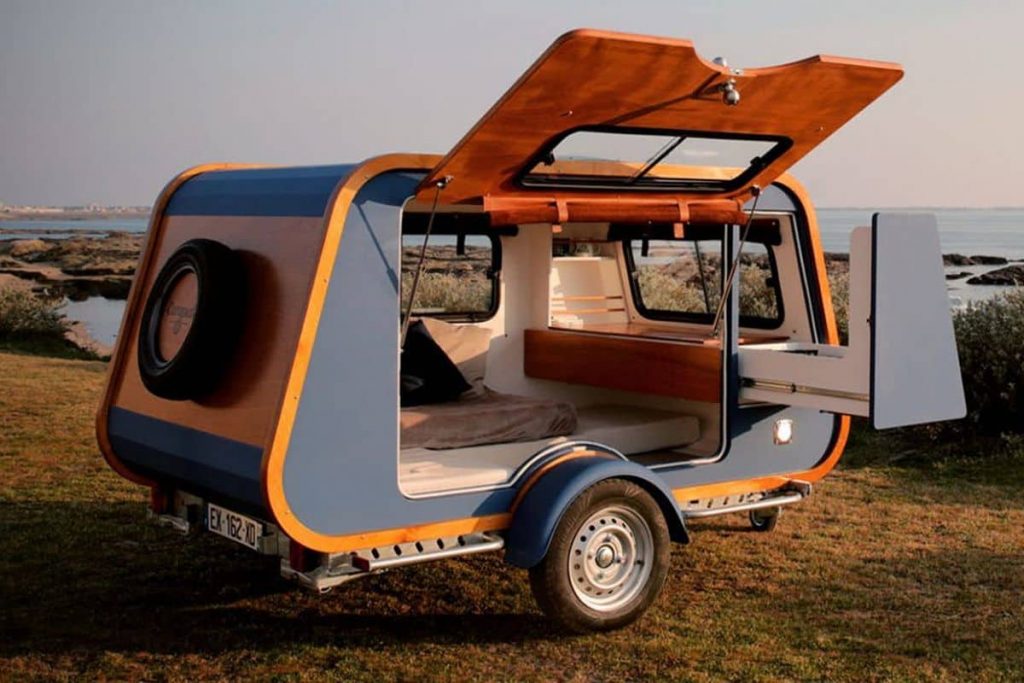
The simplest teardrop RVs are basically just a bedroom on wheels. Larger floor plans can also contain a bed, kitchen/dining area, and wet bath. Teardrop trailers are pretty comparable with the van-size Class B motorhomes in terms of space, amenities and price, with the difference being teardrops trailers are towable and can be unhitched.
Like Class B motorhomes, teardrop RVs utilize highly creative and functional designs to maximize living space and utilities, including swivel toilets, folding sinks, convertible beds, and more.
READ MORE:
Truck Campers
Pros:
- Versatile: Removable shell means you can use your truck as normal
- Relatively cheap to buy, insure and repair
- Easy to maneuver
- Great for off-roading
Cons:
- Limited living space
- Very limited amenities
- Each camper is designed for specific truck models only
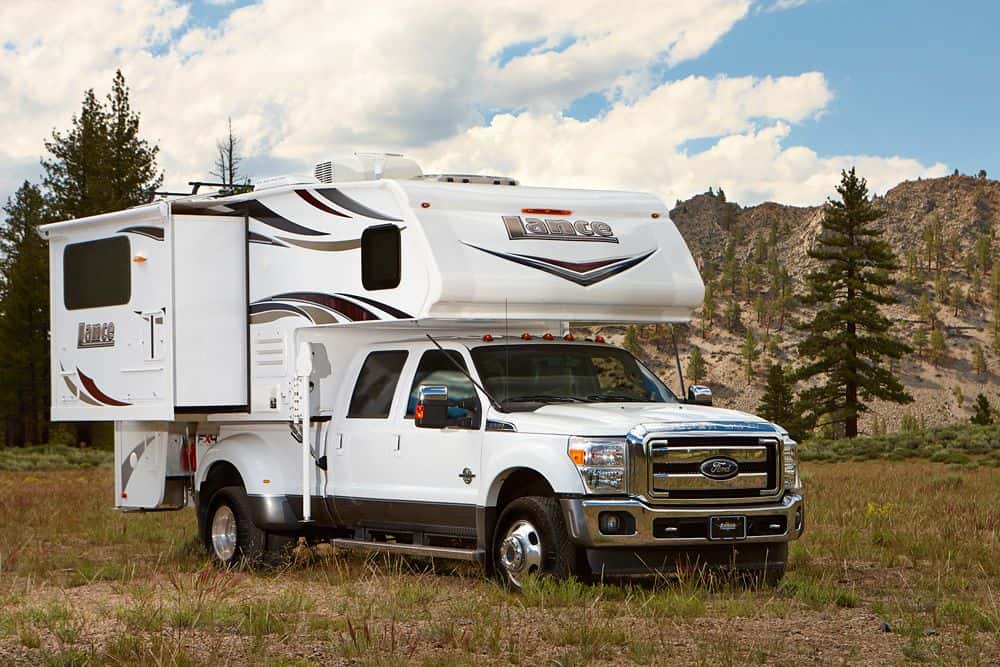
Truck campers, sometimes called “slide-ins” or “cab-overs”, feature a hard-sided camper shell that is attached to or sits on top of an ordinary pickup truck. This means great versatility and affordability, as you do not need to buy a whole new RV or upgrade your existing vehicle to tow the newly purchased RV.
Thanks to their compact size, these RVs are easy to drive. Thus, they are perfect for weekend getaways, spontaneous and outdoorsy travelers who stay outdoors most of the time, thus tend to prioritize flexibility, drivability and affordability over luxury amenities.
Truck campers typically sleep two passengers, though some may claim to sleep up to four, and offer small cooking, dining, storage and bath facilities. The overall size may only be slightly longer than your standard pickup.
>> READ MORE: Top 10 Pop Up Truck Campers For Off-Roading
Pop-up Campers
Pros:
- Lightweight and compact
- Easy to maneuver
- Can be towed by most full-sized passenger vehicles
- Affordable to buy, repair and maintain
Cons:
- Limited living space
- Little to no storage
- Not durable: canvas sides susceptible to wear-and-tear
- Thus not suited for extreme weather and long-term ownership
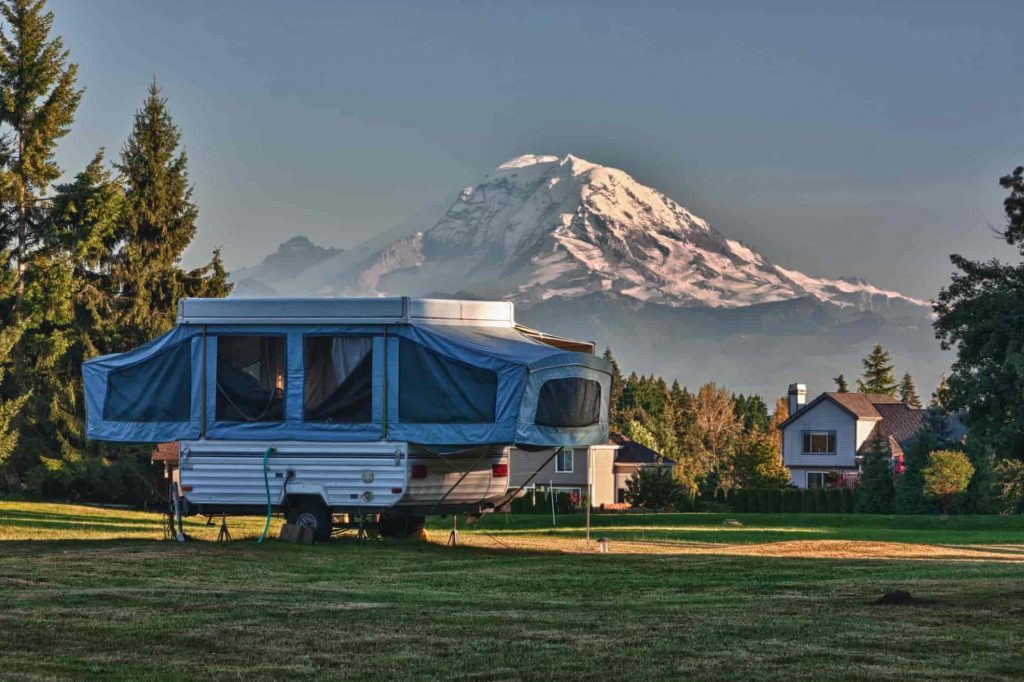
These types of RVs have a hard base with extendable canvas sides that “pop-up” to provide sleeping space, hence the name, and can be neatly folded away during travel for easy transport. A huge plus is that they are lightweight, which means they can often be towed by most passenger vehicles, so you won’t need to upgrade your family car to tow these pop-ups. These towable RVs make camping more comfortable and are available with a variety of options.
Some downsides to consider is there is minimal to no storage available and the tent-style side sections offer limited protection from extreme elements.
>> READ MORE: The 8 Best Air Conditioners for Pop Up Campers
Due to their limited space, amenities and durability, pop up campers are more suited for the occasional, spontaneous short weekend getaways than they are for long-term living and long trips. Thanks to their affordable price tags, they are also ideal for families looking to upgrade their camping experience from the usual tents and sleeping bags, or for first-time RVers testing out the waters before fully committing a large investment for more serious full-time RV-ing. They are also suitable for the budget-minded and outdoorsy travelers who can give up comfort.
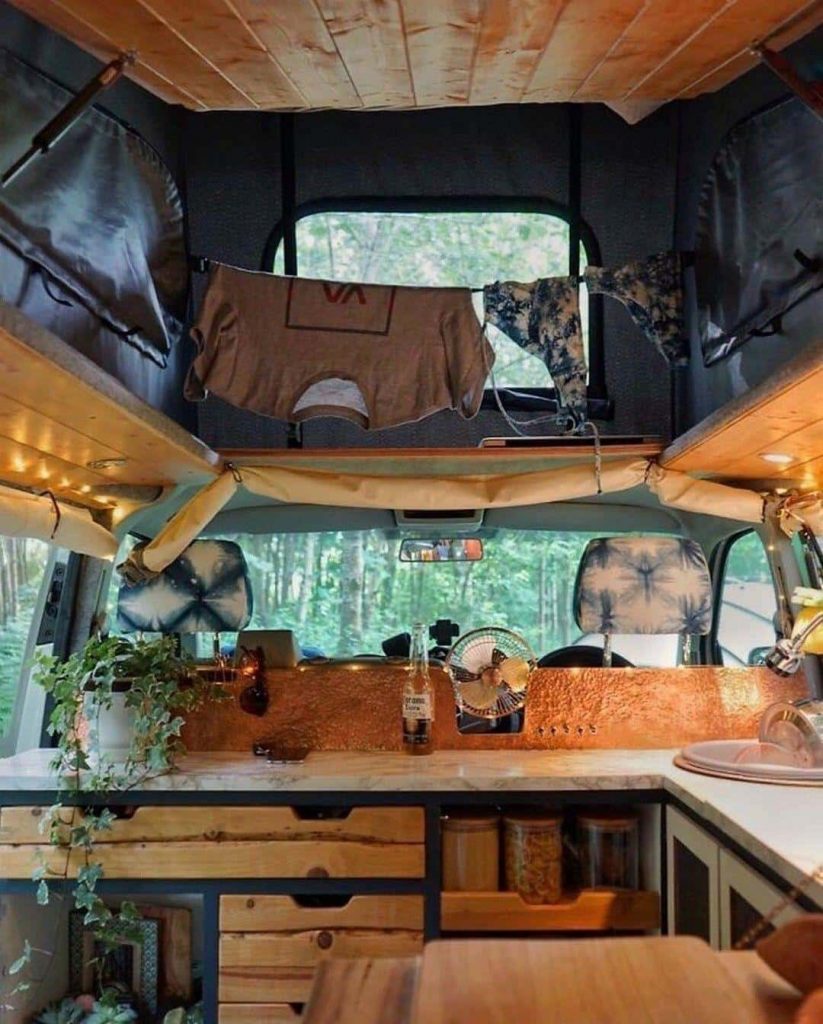
Which Types of RVs: What to Consider First
The very first thing you need to do even starting your research on which types of RVs to buy or rent is determining your needs and priority, in order to pick the optimal RV type and model. Think about how many people will share the same space, how long your trip is, the level of comfort you desire, and of course your budget.
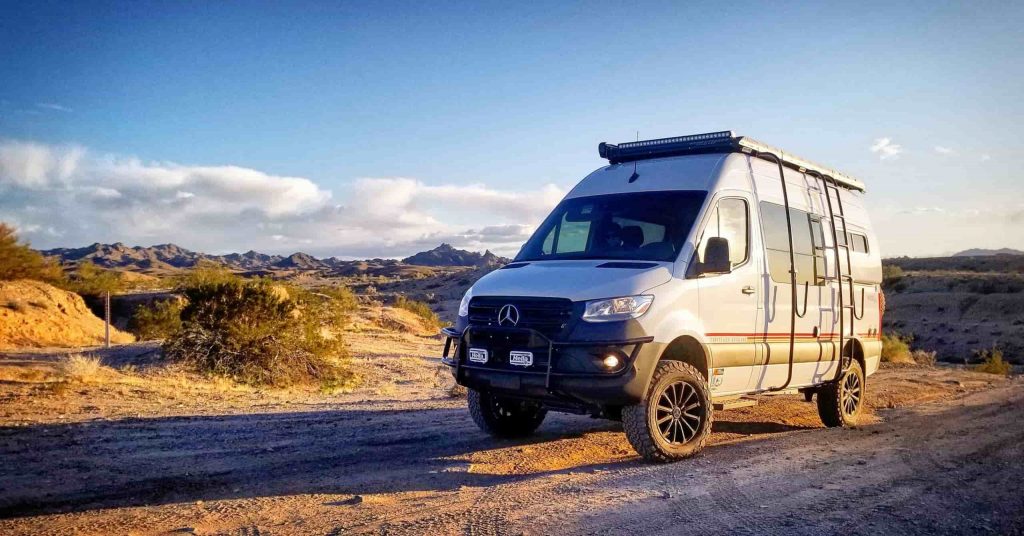
Driving the unit
An important note is it is not easy to drive the hulking gorilla around, especially on hilly, mountain roads. Therefore, choosing which type of RV to buy also depends on your driving skills and also your logistic choices.
If you would rather compromise space to have an easier driving experience on long trips, smaller sized RVs like a 21 foot rig would be much easier to drive around. Plus, smaller rigs typically have better gas mileage.
Depending on the types of RV, you might be driving in the RV itself or you would be towing it behind your car or truck. Towing would allow you to leave your rig in the parking area and go explore in your compact vehicle.
Space and sleeping arrangements
To decide what type of and which RV to buy, space and sleeping arrangements should be a major consideration. After a long day spending outdoors, every traveler will need a good night’s sleep to recharge. Sleeping space is what you would not want to compromise, especially if you plan to camp for a week and above.
RV listings will always show how many people each RV sleeps. Note that RV beds are typically hidden or convertible, so it’s best that you inquire before buying how large each bed is, and exactly how to go about converting it.
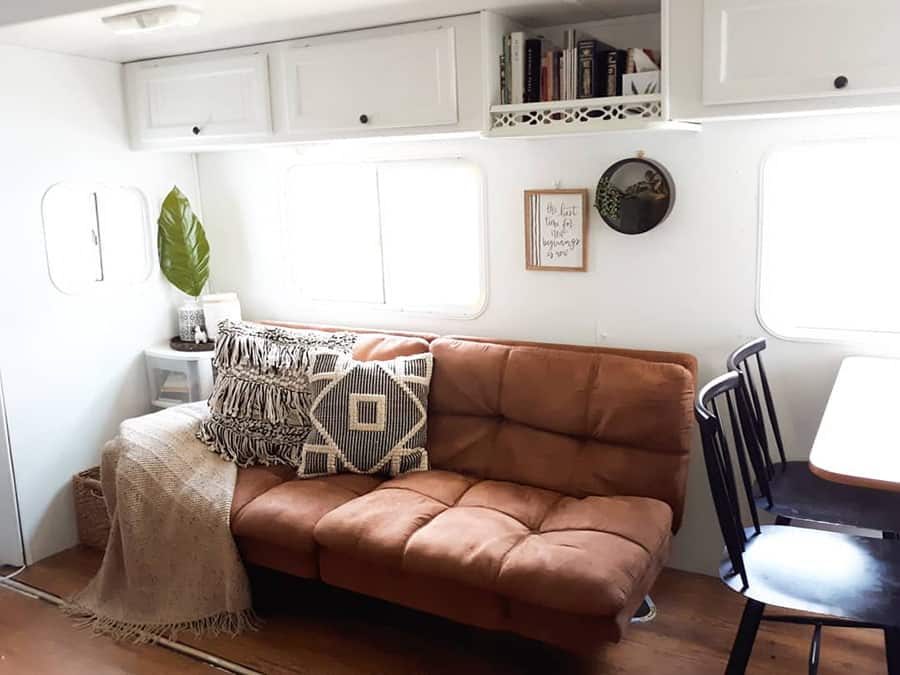
Convertibles aren’t the most comfy and spacious beds, thus inquiring beforehand will help you organize sleeping quarters for each companion.
Small groups of two or three will get all the basics covered with something like the standards 2016 R-Pod 180 Forest River, which sleeps three, possibly four petite: a queen size bed for two plus a dining area that folds out into a twin bed.
Meanwhile, bigger groups and longer trips will require a larger RV with extra storage space and amenities like the 2014 Fleetwood Bounder 33C, which sleeps six and features two slide-outs for extra living space.
Level of comfort
RVs come in all sizes and offer widely different levels of comfort. A standard RV will often have the basics: a sleeping quarter, a fully-equipped kitchen with a microwave, a gas stove, a small fridge, a full bathroom with built-in shower, a dining area with a convertible bed and an RV TV.
If you prefer more privacy or you’re traveling with a few companions, you can upgrade to an RV with a private bedroom with king size bed, a full bathroom with separate shower, which is more convenient for larger groups, a bigger and better equipped kitchen with double door refrigerator and an oven, a more comfy and spacious dining area, more than one AC units, and more storage.
